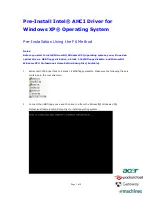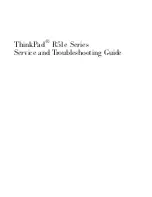
40
ExtremeWare XOS 10.1 Concepts Guide
Managing the Switch
There is no way to configure the switch to allow SNMPv1/v2c access and prevent SNMPv3 access.
Most of the commands that support SNMPv1/v2c use the keyword
snmp
; most of the commands that
support SNMPv3 use the keyword
snmpv3
.
Accessing Switch Agents
To have access to the SNMP agent residing in the switch, at least one VLAN must have an IP address
assigned to it.
By default, SNMP access and SNMPv1/v2c traps are enabled. SNMP access and SNMP traps can be
disabled and enabled independently—you can disable SNMP access but still allow SNMP traps to be
sent, or vice versa.
Supported MIBs
In addition to private MIBs, the switch supports the standard MIBs listed in Appendix C.
Configuring SNMPv1/v2c Settings
The following SNMPv1/v2c parameters can be configured on the switch:
• Authorized trap receivers
—An authorized trap receiver can be one or more network management
stations on your network. The switch sends SNMPv1/v2c traps to all trap receivers. You can have a
maximum of 16 trap receivers configured for each switch, and you can specify a community string
and UDP port for individually for each trap receiver. All community strings must also be added to
the switch using the
configure snmp add community
command.
To configure a trap receiver on a switch, use the following command:
configure snmp add trapreceiver <ip_address> community {hex} <community_name>
{port <port_number>}
You can delete a trap receiver using the
configure snmp delete trapreceiver
command.
• Community strings
—The community strings allow a simple method of authentication between the
switch and the remote Network Manager. There are two types of community strings on the switch.
Read community strings provide read-only access to the switch. The default read-only community
string is public. Read-write community strings provide read and write access to the switch. The
default read-write community string is private.
• System contact
(optional)—The system contact is a text field that enables you to enter the name of
the person(s) responsible for managing the switch.
• System name
—The system name is the name that you have assigned to this switch. The default
name is the model name of the switch (for example, BD-1.2).
• System location
(optional)—Using the system location field, you can enter an optional location for
this switch.
Displaying SNMP Settings
To display the SNMP settings configured on the switch, use the following command:
show management
Summary of Contents for ExtremeWare XOS 10.1
Page 12: ...12 ExtremeWare XOS 10 1 Concepts Guide Contents...
Page 15: ...Part 1 Using ExtremeWare XOS...
Page 16: ......
Page 20: ...20 ExtremeWare XOS 10 1 Concepts Guide ExtremeWare XOS Overview...
Page 32: ...32 ExtremeWare XOS 10 1 Concepts Guide Accessing the Switch...
Page 74: ...74 ExtremeWare XOS 10 1 Concepts Guide Virtual LANs VLANs...
Page 80: ...80 ExtremeWare XOS 10 1 Concepts Guide Forwarding Database FDB...
Page 112: ...112 ExtremeWare XOS 10 1 Concepts Guide Status Monitoring and Statistics...
Page 133: ...Part 2 Using Switching and Routing Protocols...
Page 134: ......
Page 174: ...174 ExtremeWare XOS 10 1 Concepts Guide Virtual Router Redundancy Protocol...
Page 184: ...184 ExtremeWare XOS 10 1 Concepts Guide IP Unicast Routing...
Page 202: ...202 ExtremeWare XOS 10 1 Concepts Guide Interior Gateway Protocols...
Page 216: ...216 ExtremeWare XOS 10 1 Concepts Guide Exterior Gateway Routing Protocols...
Page 224: ...224 ExtremeWare XOS 10 1 Concepts Guide IP Multicast Routing...
Page 225: ...Part 3 Appendixes...
Page 226: ......
Page 234: ...234 ExtremeWare XOS 10 1 Concepts Guide Software Upgrade and Boot Options...
Page 242: ...242 ExtremeWare XOS 10 1 Concepts Guide Troubleshooting...
Page 256: ...4 ExtremeWare XOS 10 1 Concepts Guide Index of Commands...
















































